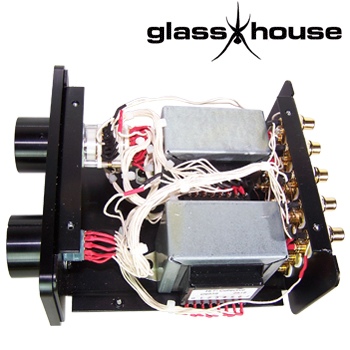Glasshouse TVC Passive Pre-amplifier kit - Description

This unit features a transformer volume control, TVC, instead of the signal being attenuated through resistors, the signal is basically piped around the windings of a transformer, the transformer is tapped and switch controlled at the front. Simple. So we thought we would have a go.
Glasshouse TVC Passive
Without changing any of the most important criteria applied to the original passive; the design keeps signal wire lengths as short as possible by keeping the chassis as small as possible (front to back distance is 160mm).
We had to source a transformer that would fit the original box and boy did we find one. With a few subtle changes to the original design to put the Glasshouse badge on, we now have be-spoke transformers that not only fits in the box, but are at an excellent price. Early reports suggest that the Glasshouse TVC passive is very close to the sound of the Music First magnetic pre-amplifier and may we add at a fraction of the cost.
The First prototype featured the new transformers, supplied with solder tags, wired with our very own HGC 99.99% silver 0.5mm diameter wire. Each transformer has 24 solder tags, once built the kit uses 10m of wire. The HGC wire, sheathed in telfon, has a diameter of 1.385mm. If you have ever worked with teflon in a restricted area you will know that it is not exactly bend friendly, preferring to take a relaxed curved pathway. When formulating a kit you must always think of the constructor, we had to find a more "bendy" wire. With this latest version of the TVC we have opted for the Jupiter awg26 copper wire in cotton sleeving, because of its ease of use and superb natural sound.
The kit is offered with the Elma switches as standard, as they offer very good performance at a sensible price point. There is the option to upgrade to the excellent Seiden switches for both the input selector and attenuator.
The Kit
The build is slightly more complex than the standard passive on account of the wiring up the transformers, but far from being complicated. You will see from the numerous pictures here that the transformer is wired to the selector externally as there isn't enough room inside to do so. Once built it is fitted in place. The kit is supplied with the fitting holes for the transformers pre-drilled.
Mechanically the kit goes together very easily as long as you have the right tools for the job and follow the recommend sequence in the instructions. With around 140 solder joins to be made it will take around 5 hours to complete, test and then play.
The Instructions provided are very clear, giving step by step details backed by pictures and diagrams. The instruction book will soon be available as a pdf file download on the site.
The Conversion Kit (from stepped attenuator version)
For those who have the original kit, that features the Dale Vishay and want to upgrade to the TVC version, we are offering a Conversion kit. All wiring from the phono sockets to the selector switch has to be removed as the transformer need the space to be clear for fitting. The stepped attenuator needs to be removed. Then, the rebuild begins.
Parts list:
- 2 x Glasshouse TVC transformer
- 11 metres x Jupiter AWG26 copper wire, cotton sleeving
- 1 x Elma 2 pole 24-way switch
- 1 x Instructions
Build requirements
To build the Glasshouse TVC Passive Pre-amplifier you will need to:
- Know how to solder a good joint
- Be aware of safety practices when it comes to electronics
- Have an understanding of switching electronics
- Be able to read a circuit diagram
- Own a multi-meter.
- Be able to fully understand the instructions provided
- Have patience, rushing creates mistakes
Kit Contents
- Chassis base, lid and 6mm front panel
- 2 x control knobs
- 9 x red phono sockets (gold plated)
- 9 x black phono sockets (gold plated)
- 1 x earth post
- 4 x M4x6mm pozi-drive screw, 1 x M4 nut as spacer to fit front panel to chassis base
- 4 x M4x6mm pozi-drive screw, 4 x M4 to fit transformers to chassis
- 8 x M3x6mm countersunk screws (to fit base and lid together)
- 3 x M3 solder tags for easy soldering of the earth post
- 1 x Elma 2 pole 6 way selector switch 01-1264
- 1 x Elma 2 pole 24 way attenuator switch
- 2 x Glasshouse TVC Transformers
- 11 metres x Jupiter AWG26 copper wire, cotton sleeving
- 5 metres x 3.8% Silver/gold Mundorf solder
- Suitable lengths of red and black heat shrink 2.4mm diameter for terminating the wire
- 4 x Rubber adhesive feet
- 20 x Cable ties
If you do have problems, we can help via the telephone or email or you can return her to base for repair.
At the end of the experience you will have a kit that not only looks amazing but it will sound awesome for many years to come.
Upgrade options:
If you require upgraded switches, RCA sockets or wiring from the vast selection available, then please email us for a quote: info@hificollective.co.uk
PRICE (1 kit)
£620.00 +vat +p&p
We also offer a building service of £200.00 +vat
